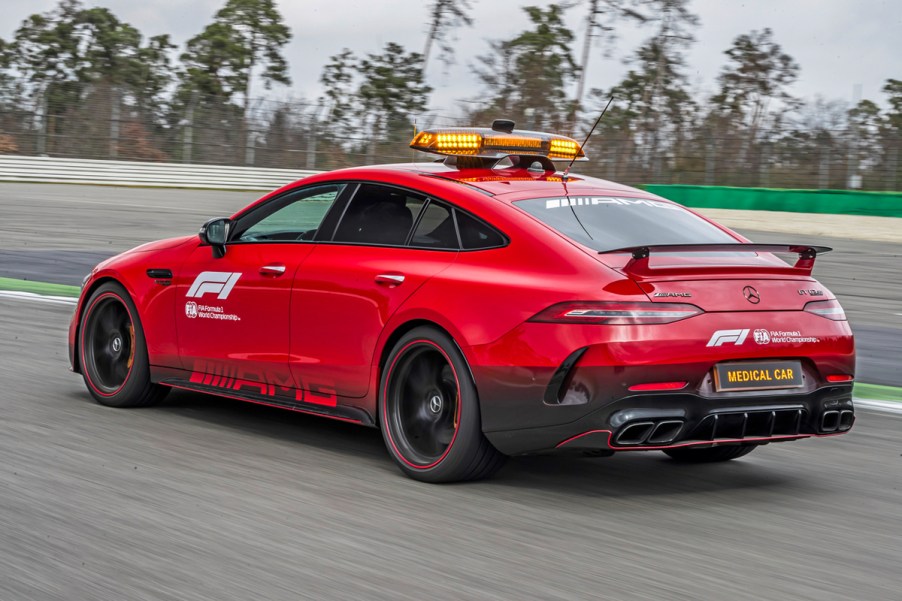
This Is the Fastest Ambulance in the World
Motorsport is inherently dangerous, and to keep drivers safe and respond to accidents as quickly as possible, the safety crews need to be well equipped and highly trained. When F1 drivers take to the grid, their safety depends on some of the most sophisticated technology in motorsport. But, when everything goes wrong, the F1 medical car is there to respond as quickly as possible. It’s no good to have a lumbering, five-ton van tootling around the race track. The fastest racing series in the world needs the fastest ambulance in the world.
Mercedes-AMG has just announced the new safety and medical cars for the 2022 F1 season. They’ve replaced the old cars that have been in use since 2015 and will share duties with Aston Martin. This is everything you wanted to know about the fastest ambulances in the world.
To make the fastest ambulance, start with the fastest car

For the 2022 F1 racing season, the previous medical car, a Mercedes-AMG C 63 S Wagon, has been replaced with the formidable GT 63 S 4Matic+. Powered by a 4.0-liter twin-turbocharged V8, the GT 63 S 4Matic+ puts 639 horsepower to all four wheels and delivers a 0 to 60 time of 3.2 seconds. The new medical car can also hit a top speed of 195 mph.
The 4Matic+ all-wheel drive system ensures that the medical car can respond as fast as possible to on-track incidents in any weather condition. The previous C 63 S Wagon was rear-wheel drive only.
The GT 63 S F1 medical car shares its DNA with the road car but benefits from all of the engineering know-how of AMG. This is a car that has to work all day, every day, and comes equipped with AMG’s SPEEDSHIFT MCT 9G transmission, dynamic engine mounts, and fully locking differentials.
How the F1 medical car works
AMG modified the medical car significantly to support F1. The car actually spends quite a lot of time in the wind tunnel to ensure that the emergency lights don’t interfere with the car’s aerodynamics. AMG adds a high-downforce rear wing, front splitter, and a diffuser which are set at the highest possible downforce settings.
Inside, the medical car has four racing seats with six-point harnesses. These are occupied by the driver, who is a professional racing driver, the FIA’s Medical Rescue Coordinator, and two local medics. They all benefit from a suite of technology and medical equipment fitted to the car.
The trunk is full of emergency medical equipment, including a defibrillator, breathing apparatus, two fire extinguishers, and a rescue cutter. The cabin has three tablets and an additional monitor that shows a feed from the exterior cameras. The medical car also has WLAN and an in-car WiFi hotspot. A sophisticated radio system allows communication between race control, the teams, and the onsite medical facility.
Interestingly, all F1 drivers have sensor-equipped racing gloves that monitor, in real-time, heart rate and blood-oxygen levels. This information is accessible to the medical car and paramedics, who can coordinate emergency care.
The medical car has a big brother, the F1 safety car
The most visible emergency vehicle at an F1 race is the safety car. In 2022, that job goes to a brand new Mercedes-AMG GT Black Series car. This replaces the AMG GT R. We’ve reported on the normal AMG GT Black Series before, but as a quick reminder, the roadgoing racer has a twin-turbocharged V8 with 730 horsepower. The standard car recently won Car and Driver’s Lightning Lap competition, becoming one of the fastest cars ever tested.
The F1 safety car serves much the same purpose as a pace car. Its job is to control the field when there is an accident on the track. The GT Black Series is one of the fastest cars in the world, but its performance pales in comparison to a modern F1 car. At any given circuit, the safety car is around one minute per lap slower than an F1 car.
Mercedes shares safety and medical car duties with Aston Martin in 2022. When the AMGs are not on track, Aston Martin will supply a Vantage and DBX SUV.
The 2022 F1 season is set to be one of the best, with the fastest race cars and drivers battling for the championship. They will now be kept safe by two of the fastest road cars in the world, and in the case of the GT 63 S, the fastest ambulance ever made.


